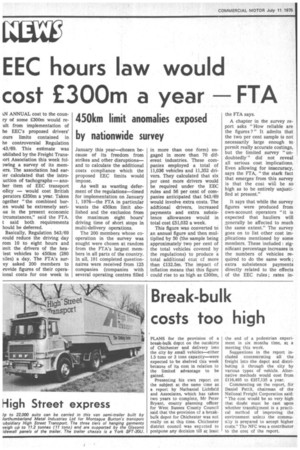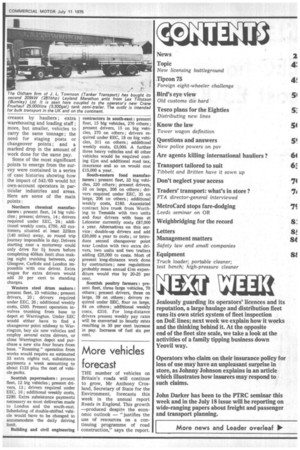EEC hours law would cost £300m a year FTA
Page 4

Page 5

If you've noticed an error in this article please click here to report it so we can fix it.
450km limit anomalies exposed by nationwide survey
iN ANNUAL cost to the counry of some £300m would reult from implementation of he EEC's proposed drivers' ours limits contained in he controversial Regulation 43/69. This estimate was .ublished by the Freight Transport Association this week folawing a survey of its mempers. The association had earier calculated that the intro-uction of tachographs — anoher item of EEC transport policy — would cost British perators £350m a year. Taken ogether "the combined bur[en would be extremely serius in the present economic ircumstances," said the FTA. t said both requirements hould be deferred.
Basically, Regulation 543/69 vould reduce the driving day rom 10 to eight hours and =it the drivers of the heajest vehicles to 450km (280 rules) a day. The FTA's surey asked 200 members to Provide figures of their operaional costs for one week in January this year—chosen because of its freedom from strikes and other disruptions— and to calculate the additional costs compliance which the proposed EEC limits would impose.
As well as wanting deferment of the regulations—timed for implementation on January 1, 1976—the FTA in particular wants the 450km limit abolished and the exclusion from the maximum eight hours' driving time of short stops in multi-delivery operations.
The 200 members whose cooperation in the survey was sought were chosen at random from the FTA's largest members in all parts of the country. In all, 191 completed questionnaires were received from 125 companies (companies with several operating centres filled in more than one form) engaged in more than 70 diferent industries. These companies employed a total of 11,036 vehicles and 11,352 drivers. They calculated that six per cent more drivers would be required under the EEC rules and 56 per cent of companies anticipated that 543/69 would involve extra costs. The addtional drivers, increased payments and extra subsistence allowances would in total cost £51,032 a week.
This figure was converted to an annual figure and then multiplied by 50 (the sample being approximately two per cent of the total vehicles covered by the regulations) to produce a total additional cost cf more than £132.5m. The impact of inflation means that this figure could rise to as high as £300m, the FTA says.
A chapter in the survey report asks "How reliable are the figures ? " It admits that the two per cent sample is not necessarily large enough to permit really accurate castings, but the limited survey " undoubtedly " did not reveal all serious cost implications. Even allowing for inaccuracy, says the FTA, "the stark fact that emerges from this survey is that the cost wiii be so high as to be entirely unjustified at present."
It says that while the survey figures were produced from Own-account operators "it is expected that hauliers will generally be affected to much the same extent." The survey goes on to list other cost implications mentioned by some members. These included : significant percentage increases in the numbers of vehicles required to do the same work ; extra subsistence payments directly related to the effects of the EEC rules ; rates in creases by hauliers ; extra warehousing and loading staff ; more, but smaller, vehicles to carry the same tonnage; the need for staging posts or changeover points ; and a marked drop in the amount of work done for the same pay.
Some of the most significant points to emerge from the survey were contained in a series of case histories showing how the impact of 543/69 would hit own-account operators in particular industries and areas. Here are some of the main points : Northern chemical manufacturers: present fleet, 14 big vehicles; presen: drivers, 14; drivers required under EEC, 24; additional weekly costs, £750. All customers situated at least 225km (140 miles) away, so round trip journey impossible in day. Drivers starting near a motorway could only drive for 51 hours before completing 450km limit thus making night trunkring between, say Glasgow, Carlisle and London impossible With one driver. Extra wages for extra drivers would add 30 per cent to standing charges.
Western steel drum makers: present fleet, 23 vehicles ; present drivers, 20; drivers required under EEC, 26; additional weekly costs, £500. Present operation involves trunking from base to depot at Warrington. Under EEC would either have to find a changeover point Midway to Warrington, buy six new vehicles and employ several extra drivers, or close Warrington depot and purchase a new site four hours from base. "Roarriing " operation from works would require an estimated 33 extra nights out, subsistence payments a week amounting to about £123 plus the cost of vehicle parks.
Scottish papermakers : present fleet, 12 big vehicles; present drivers, 13; drivers required under EEC, 16; additional weekly costs, £290. Extra sUbsistence payments necessary as most deliveries made to London and the south-east. Scheduling of double-shifted vehicle would have to be changed to accommodate the daily driving limit.
Building and civil engineering
contractors In south-east: present fleet, 15 big vehicles, 270 others ; present drivers, 15 on big vehicles, 270 on others ; drivers required under EEC, 18 on big vehicles, 311 on others ; additional weekly costs, £3,000. A further three heavy vehicles and 40 other vehicles would be required costing £.-1-in and 'additional road tax, insurance and so on would cost £15,000 a year..
South-eastern food manufacturers: present fleet, 32 big vehicles, 220 others ; present drivers, 32 on large, 206 on others; drivers required under EEC, 35 on large, 206 on others ; additional weekly costs, £180. Associated contract •hire trunk from Worthing to Teesside With two units and four drivers with base at Leicester currently costs £87,000 a year. Alternatives on this service: double-up drivers and add £20,000 a year to costs ; or introduce second changeover paint near London with two extra drivers, two units and two trailers adding £25,000 to costs. Most of present long-distance work done by contractors; new regulations probably mean annual Elm expenditure would rise by 20-25 per cent.
Scottish poultry farmers : present fleet, three large vehicles, 70 others ; present drivers, three on large, 59 on others ; drivers required under EEC, flour on large, 64 on others ; additional weekly costs, £310. For long-distance drivers present weekly pay rates will be converted to hourly rates resulting •in 30 per cent increase in pay. Increase of fuel six per cent.












































































































































